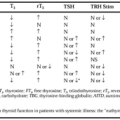POPULATION EXPOSURE TO IODIDE
Part of “CHAPTER 37 – ADVERSE EFFECTS OF IODIDE“
Iodine is a requisite part of the thyroid hormone molecule, and a deficiency or excess of iodine can dramatically affect thyroid gland function. In 1820, iodide therapy was being used in Europe for the treatment of goiter; shortly thereafter, cases of probable thyrotoxicosis were reported in a few patients receiving this treatment. Although iodide supplementation has been adopted worldwide in the past 50 years, concern remains over the danger this poses to certain susceptible individuals.1,2
Iodine deficiency and goiter remain major health problems in many parts of the world. During the two decades from 1965 to 1985 in the United States, however, iodine supplementation resulted in an increased prevalence of disordered thyroid regulation resulting from iodine excess.1,2 and 3 Although the normal thyroid gland usually adapts readily to extremes of iodine intake, some persons are vulnerable to the induction of goiter, hypothyroidism, or hyperthyroidism with exposure to excess iodine. This risk may be diminishing, for it appears that iodine intake in North America is on the decline, conceivably secondary to a reduction in its use as a preservative and disinfectant in the food and dairy industry.4
Stay updated, free articles. Join our Telegram channel

Full access? Get Clinical Tree





